Skoda Octavia 2.0 TDI
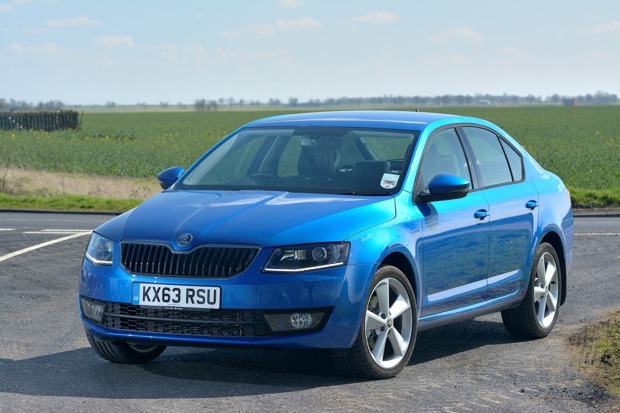

- Skoda Octavia joins the HJ fleet
- Skoda Octavia suffers a hit and run
- European adventures with the Octavia
- I like big boots and I can not lie
- Are you sitting comfortably?
- Get with the program
- Skoda Octavia v Mazda 6
- The petrol or diesel dilemma
- Marking D-Day's 70th anniversary
- Go west, where the skies are blue
- Are car extras a waste of money?
- Final thoughts on the Skoda Octavia
Skoda Octavia joins the HJ fleet
It’s time to welcome the newest addition to our fleet – the Skoda Octavia 2.0 TDI which we'll run for six months.

Date: 28 February 2014 | Current mileage: 200 | Claimed economy: 68.9mpg | Actual economy: 50.7mpg
With spring almost upon us, the time has come for me to say goodbye to the Ford Fiesta and welcome the arrival of my new car, the Skoda Octavia. I’ve heard a lot of good things regarding Skoda in recent months and have been itching to get one of their cars in as a daily runner to see how it performs.
For the next six months I'll be running one of Skoda's hatchbacks - the Octavia – and have opted for a diesel as I do a lot of motorway driving. Skoda actually has a few diesel options - 1.6 and 2.0 TDI - but I’ve gone for the 2.0-litre version as I regularly lug large items (and larger people) around. On paper the diesel looks good value, with 150PS and a claimed 68.9mpg. Emissions are low too at 106g/km, which means road tax is just £30 a year - not bad when you consider the Octavia is 15 foot long and has 320Nm of torque.
I have to admit that I struggled to choose between the hatch and estate - both look great and boast cavernous interiors. However, being a man without a family, I’ve decided to opt for the hatch as I think its 590 litres of boot space will be more than enough for my needs. I also think the Octavia looks a lot sleeker in hatch form, with a sharp angular front end a swooping rear. I know its early days (I’ve only had the car two weeks) but I really like the design and haven’t regretted the decision to choose it over the estate.
My Octavia comes in the range topping Elegance trim, which is packed with all manner of toys, like a colour trip computer, DAB infotainment system and dual zone climate control. I’ve resisted the urge to specify the DSG gearbox, so my Octavia gets the standard six-speed manual, which should allow the 2.0 TDI to rattle from 0-62mph in 8.5 seconds. If left unguarded, the Octavia will gallop along to a top speed of 135mph, which isn’t bad for what is essentially a family diesel car.
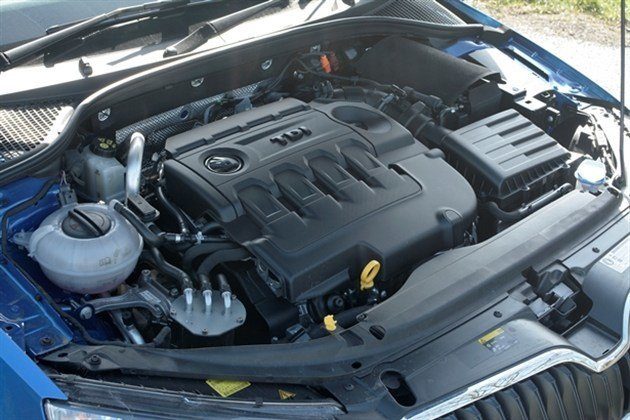
The Skoda Octavia is powered by a turbocharge 2.0-litre diesel, with 150PS and 320Nm of torque
As usual, I’ve added a scattering of extras to see if they represent value for money. I usually take a sceptical view towards paying money to ‘improve’ a car and always wondered if the optional toys are actually worth the faff. However, Skoda’s options list is comprehensive and there’s a lot of gear that looks half useful. As a result, I’ve added the winter pack, boot net, simply clever package and a few other items to my car, which include metallic paint and alloy wheels. Over the next six months I’ll be assessing the options, along with the standard kit, to see what works and what doesn’t.
So far first impressions have been positive. The Octavia looks great in Race Blue metallic paint and has acres of space inside. Admittedly, I have only covered 200 miles, but have been pleased with the car’s refinement. The cabin is also neat and quiet, which makes it a pleasant place to spend time. I particularly like the optional leather seats, which are extremely comfortable and supportive.
The 2.0 TDI engine is very smooth and packs a punch for overtaking. I’ve also been impressed with the six-speed manual ‘box, which is slick and has a nice spread between the ratios. So far the fuel economy has been a modest 50.7mpg, but I have a number of long trips coming up and will see how that improves as I put the Octavia to task on the motorway.
The standard kit in Elegance trim is pretty good and I’ve already mastered the infotainment system and hooked up my mobile phone. I’ve also had a dabble with the car’s Driving Mode Selection - normal, eco, sport, individual - which allows the driver to tailor the Octavia’s handling and performance. I’ve not found the right balance yet, but plan to spend the next few weeks trying each setting to see what effect the have on economy and road handling.
Skoda Octavia suffers a hit and run
The Skoda might be fresh out of the box, but that hasn't stopped someone hitting it in the local car park.
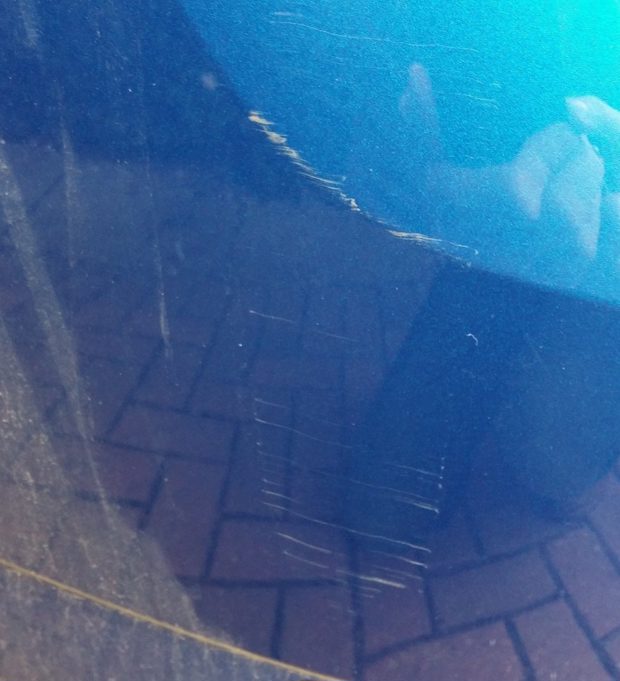
Date: 14 March 2014 | Current mileage: 590 | Claimed economy: 68.9mpg | Actual economy: 55.9mpg
I might only be a month into my Skoda Octavia loan, but I already have some bad news: the car has been hit by a dishonest driver. Well I say ‘hit’, it's more of a scrape, but it is equally as infuriating. I made the grim discovery last week as I washed the car and as you can imagine I was livid when I found a five-inch high scrape on the nearside corner of the rear bumper. Is there anything more annoying that having your new car dinged by someone who can’t park?
Normally, under such circumstances, I would unleash the winged monkeys from HJ Towers to hunt down the individual responsible and demand payment for the repair, but I have no idea when or where it happened. you see, the damage was covered up by wintery salt and grime and has remained hidden for at least a week, which means it was either in a supermarket or airport car park.
What I do know is, around two weeks ago, some driver out there has misjudged a parking spot and hit my car. Thanks, whoever you are!
Keen to rectify the situation, I booked the Octavia into my local dealer - Vindis Skoda Cambridge - who inspected the scrape and arrange a day and time to get it fixed. The dealership is just around the corner from where I live and they wasted no time in organising the repairs.
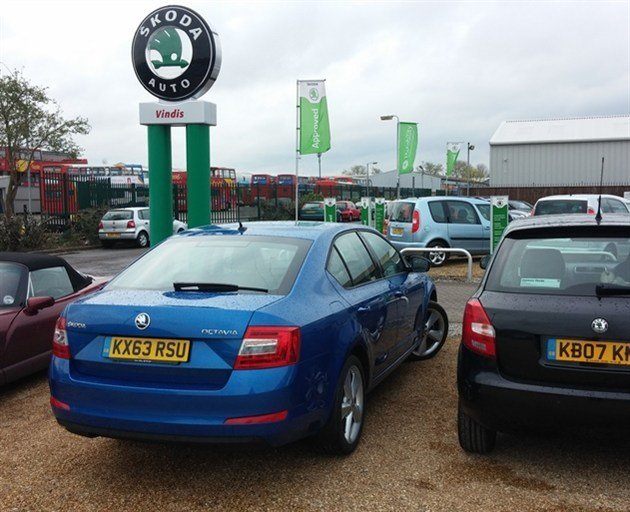
A visit to Vindis Skoda Cambridge was in order after Dan discovered the Octavia had been damaged
Due to the nature of the damage, the Octavia qualified for a ‘smart repair’, which is a low cost option compared to a traditional bodyshop fix. Skoda’s smart repair system specialises in light scuffs and scratches, and also extends to alloy wheel refurbishments and interior trim fixes.
The damage on my Octavia's paintwork wasn't too deep and it was more of a case of cleaning the area and touching up the paint than straightening panels. As a result, it took less than a full day to complete and cost £100. The fix was as good as new and you'd struggle to tell it had been damaged. What’s more, Skoda tell me that some insurance policies provide cover for 'smart repairs' and the work can be completed for free, without compromising the no claims bonus. However, as always, double check with your insurer before asking for a free fix...
Bodywork damage aside, I’ve been very happy with the Octavia. Over the last month I have covered close to 600 miles and have really been impressed with the Skoda's refinement. On the motorway the 2.0 diesel engine is quiet and powerful, while the six-speed manual ‘box is one of the slickest units I’ve ever experienced in a large saloon.
I’ve also been pleasantly surprised with the fuel consumption, with the car’s on-board computer reporting 55.9mpg. Over the next few weeks I will be clocking up the miles in the Skoda, with a few long runs planned. I will also be taking it to France for a few days and will see how it copes with the long autoroute runs and inevitable stop at Cite de Europe in Calais. However, no matter what happens on the road, I will be keeping a careful eye on parking in future and giving the car a quick inspection each time I return with my weekly shop.
European adventures with the Octavia
Dan tests the Skoda on the continent with a weekend trip to France and Belgium.
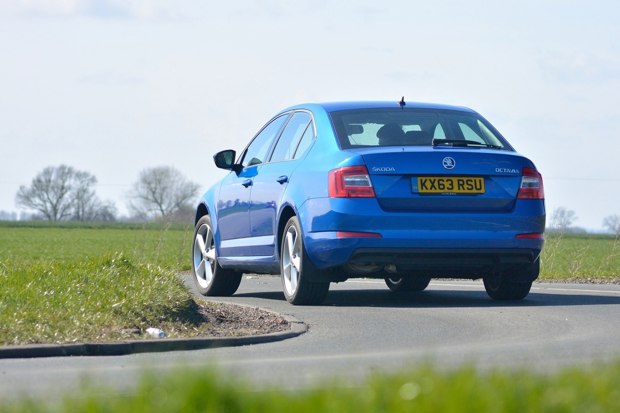
Date: 28 March 2014 | Current mileage: 1347 | Claimed economy: 68.9mpg | Actual economy: 52.4mpg
It has been a busy few weeks for the Skoda Octavia, with it clocking up the miles in both the UK and Europe. You see, after a more than a month in service in the Powell household, I decided to press-gang my Octavia into a run to the continent, in the form of a family trip to France and Belgium.
Admittedly, this trip was relatively short – just a weekend away – but it would present a good test for the Octavia, with four adult passengers and lots of motorways and B-roads to navigate. There would also be the customary stop at a French supermarket on the way home, so the Skoda’s carrying capacity would be in for a serious test.
So, without fuss, I collected my parents and brother and headed for the channel in the wee small hours. Our arrival at Dover was largely uneventful, although the crossing was busy, which meant I was directed to the very back corner of the ship’s load deck. Yet, despite its size, the Octavia is very light on its feet at low speeds, which makes parking surprisingly easy.
I was also greeted a chorus of compliments from my passengers in relation to the Octavia’s size and refinement. Indeed, my companions were not wrong, the Skoda is cavernous inside and has little trouble accommodating four adults. In fact, I reckon it would accommodate a fifth in comfort, but that test will have to come another time. For now, the Octavia scores five stars for passenger comfort, with particular praise given to the optional leather seats that offer plenty of support for all ages.

It might be big, but the Skoda is extremely nimble and that makes parking manoeuvres a doddle.
Once in France, I was able to open up the Ocatvia a little as the French autoroutes are generally quiet and relaxing. The first leg of our journey involved a run to Dunkirk, where we spent one night, before going on to Ghent in Belgium. The trip was serene and pleasant, while the 2.0-litre diesel engine was exceptionally smooth and quiet. In fact, you’d be hard pressed to tell it apart from its petrol counterpart, such is its refinement.
The Octavia can also shift up a gear at pace, with its six-speed manual 'box being the perfect bridge for the car's 320Nm of torque and 150PS. Thump the throttle and Octavia will scamper away with impressive gusto and overtaking is a relatively short experience. For the mainstay of driving, the Octavia returns around 50-55mpg, but if you resist the need for speed then this will climb to 60mpg. However, being from Essex, I am naturally inclined towards 'spirited' driving, which meant I failed at this challenge and ended up with an average of 52.4mpg.
The weekend trip also allowed me to identify some of the Skoda's highlights. You see, for a few weeks now, I've been establishing a strong admiration for the Octavia and its design. The car is attractive and the cabin is excellent, with a workmanlike simplicity that’s usually the reserve of Audi. Take the touchscreen infotainment for example; it’s large, colourful and filled with large and easy to use buttons. Not only does it take a matter of seconds to program the sat nav, radio or media system, but I was also able to train my technophobe dad to use it in the space of five minutes – high praise indeed for anyone who knows him.
There are a couple of niggling issues that could be improved; the indicator stick feels a little flimsy and the cruise control button is fiddly to use as it’s located on the top of the indicator stick. The boot lid also has a tendency to retain water, which means it leaks onto the contents of the boot when you open it. However, these minor issues are not enough to discourage my affection for this excellent hatch and it’s still a case of ‘so far so good’ for the Octavia.
I like big boots and I can not lie
With 590 litres of storage on offer, Dan has been living life to the full with the Skoda Octavia.
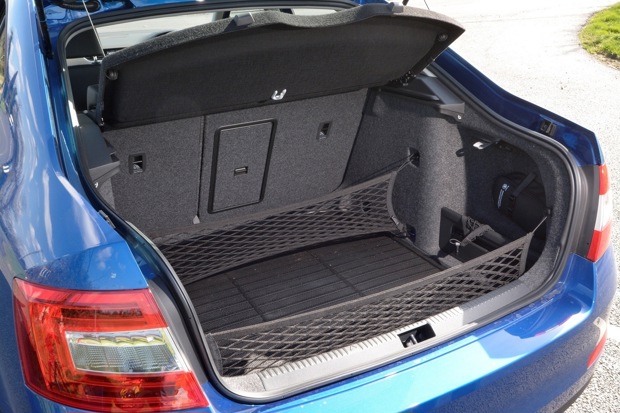
Date: 11 April 2014 | Current mileage: 1612 | Claimed economy: 68.9mpg | Actual economy: 54.1mpg
There’s something undeniably satisfying about having a car with a big boot. Take my Skoda Octavia for example; it has a whopping 590 litres of boot space, which makes it perfect for everything from the weekly shop to the monthly trip to the tip. Yet, to look at it, you’d be forgiven for thinking the Octavia is not such a big hitter when it comes to storage.
Indeed, from the exterior, the Octavia looks like a standard saloon and I’ve had a number of people express surprise when I’ve explained it’s actually a hatchback. The source of the confusion lies in the body style, with the rear of the car being very saloon-like in its appearance. In fact, the rear of the Octavia is very similar to the first generation Audi A4, with the square lights and shape giving it a very elegant appearance.
As I’ve said in previous updates, I’m really impressed with the attractive exterior of the Octavia and in my book it looks all the better with the Race Blue metallic paintwork, which I specified for an additional £525. Make no mistake, a colour makes the car and I really think Skoda's blend of dark purple and sea blue is a perfect match for the Octavia's sloping lines.
But enough of me waxing lyrically about paint schemes; this is an update about storage and here the Skoda Octavia reigns supreme. Over the past two months I’ve used it a lot for shifting things around and even got a set of mountain bikes in there by pushing down the rear seats.
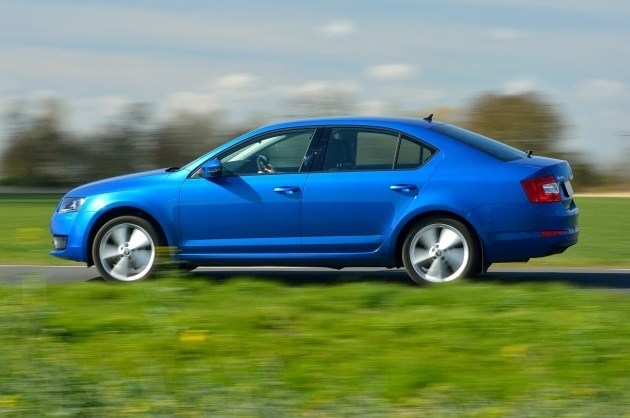
Contrary to popular belief, the Skoda Octavia is a hatchback and not a saloon
The Skoda’s boot is aided by some clever options, with a set of nets (£50) and the Simply Clever pack, which includes a double sided boot floor. In regards to the former, the nets are hugely practical and perfect for preventing the weekly shop from rolling around the boot floor. Sometimes, with large cars, a big boot can result in items crashing around or falling over and making a mess, but not here. The nets are extremely smart and ensure everything packs away neatly.
I’m also a big fan of the double sided boot floor. On the one side the floor is hard wearing, with a rubber surface that is great for muddy boots or bikes, while the other side is carpeted and apt for all other uses. In my opinion, the two options are well worth the money and genuinely make life easier, which can’t always be said for car extras.
I tested the Octavia's load capacities to the hilt last week when I helped a friend prepare for a party. The friend in question needed some help transporting a rather large quantity of drink and he was in the process of paying £30 for a delivery before I stepped in and offered my help. The deal? I help transport the drink if I get first dibs on the bitter. Needless to say, the Octavia was more than up for the task, with 20 odd cases of booze packed into the back. What’s more, the boot nets also served as perfect holders for the wine bottles, which ensured no spillages on the journey. Perfect!
Admittedly, I'm not sure Skoda had alcohol transportation in mind when it came designing the boot of the Octavia, but it is more than up to the task. As the weeks tick by I will see what else I can fit into it. As usual, you'll be able to read my escapades here...

Dan’s become extremely popular at his local cash and carry, with the Octavia more than apt for lugging huge loads
Are you sitting comfortably?
Prolonged sitting in a car is never good for the back or joints, but Dan thinks he has found the answer in the Skoda Octavia.
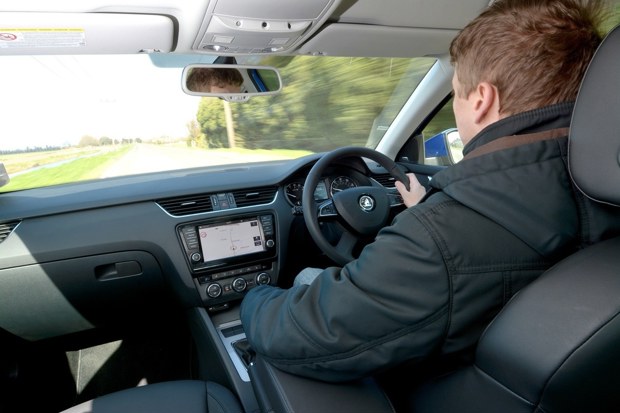
Date: 25 April 2014 | Current mileage: 2140 | Claimed economy: 68.9mpg | Actual economy: 56.5mpg
When it comes to finding a comfortable car, you’ll be forgiven for thinking all cars are the same. After all, aren’t modern cars designed in labs, with men in white coats and machines that go ping? Surely a comfortable set of seats is the first thing they look at when it comes to building a car interior, yes? Err, no.
During my eight year career as a car journalist, I have driven around 250 cars and I would say less than a third of them contained seats that I would describe as comfortable or pleasant. You see, the advent of modern motoring has brought us many wonderful things - airbags, heated front windscreens, satellite navigation, cupholders – but comfortable seating with ample back and leg support isn’t one of them.
In fact, I’ve secretly assumed that some manufacturers forget all about the seats, until the last moment of production. “Quick Jurgen, go out and buy an old set of rusty springs and some crappy fabric, we’ve forgot the damned seats again!”
Thankfully, not all cars or manufacturers are the same and when it comes to in-car comfort my Skoda Octavia really is one of the most comfortable cars you can get for under £30,000. Not only are the seats large, supportive and soft, but they are also fully adjustable and a pleasure to use for long trips. I can't fault it.

The Skoda Octavia’s leather seats (standard on Elegance trim) are well worth the extra cost, according to Dan
I should point out that leather seats are not fitted as standard on all Octavia models; it's only cars in Elegance trim that get this luxury, but the standard cloth seats are commendable enough. However, should you go for the full leather treatment, you get a whole new world of comfort, with soft materials and decent dimensions. To improve things further, I added the heated front option to my car as I am not a fan of a freezing car on cold mornings.
However, regardless of the decision to go for heated seats (or not, as your case may be), there's no escaping the supreme comfort of the Skoda. Over these past two weeks I've covered 500 odd miles, which included a round trip from Cambridge to Leeds, yet I've no complaints to make.
Sometimes new cars can leave your back sore and upper legs stiff after a long run, but I've been genuinely impressed with the Octavia's interior comforts. The rear of the Octavia is huge to, with ample leg room for adults and kids alike, which has seen it employed as a the family taxi, with all manner of relatives asking for lifts or help moving things.
Cabin comfort aside, the 2.0-litre diesel engine has also been running well, although I’m slightly disappointed with its average of 56.5mpg. Okay, so it’s just 10mpg off its official reading and 4mpg higher than its Real MPG rating, but I still expect more. In fact, over the next two weeks, I’ll seeing how much fuel I can squeeze out of the Skoda’s diesel engine and see if I can crack that all-important 60mpg barrier. But no matter what I do in the Octavia, I won't be wanting for comfort, that's for sure.
Get with the program
The Octavia’s driving program has a mode to suit all moods, but are they really necessary?

Date: 9 May 2014 | Current mileage: 2570 | Claimed economy: 68.9mpg | Actual economy: 58.1mpg
Three months into my long term loan and the Skoda Octavia has been a sure-fire winner in the Powell household. But (and there’s always a ‘but’ for us car journalists) I have been a little disappointed with the fuel economy. As a result I’ve been looking at ways to improve the average consumption and been dabbling with the Octavia’s Driving Mode Selection system, which is standard from SE trim upwards.
For those of you who are not aware of Skoda’s Driving Mode Selection system, it is a computer that allows the driver to adapt the car’s behaviour to match their mood. In theory, it’s great, because it lets you customise the car’s handling and engine response with three pre-programed modes – Normal, Sport and Eco – plus the option to tailor the car to match your own individual setting.
Regular readers will know that I enjoy a ‘spirited’ drive and I’d be lying if I said I hadn’t used the Skoda’s Sport mode a few more times than I should. However, in my defence, the Octavia is a real hoot in Sport mode, thanks to a sharp throttle response and super firm handling. Okay, it’s no SL AMG, but it’s still a lot of fun for what is essentially a big, diesel hatchback.
However, as fun as the Octavia is, with its thrifty handling and silky smooth 2.0-litre diesel engine, the fuel economy suffers in Sport with a disappointing 45mpg. So, keen to improve the economy, I’ve scaled back the pedal to the metal driving and employed the car’s Eco mode.

The Octavia's Driving Mode selector is operated via a button on the centre console
The Eco driving mode is quite clever because it doesn’t make any dramatic changes to the Octavia’s handling or performance; instead, it optimises the engine and gearbox performance to save fuel. It also reduces the air conditioning, to improve economy.
On the road the Octavia feels pretty much the same as it does in Normal mode, with decent acceleration and plenty of feedback through the car’s large steering wheel. Admittedly, the reduction in the air con is noticeable on a hot day, but that’s about it really. As a result, I’ve seen the Octavia’s fuel economy climb to 58.1mpg.
While on the subject of the Octavia’s internal wizardry, I must also give praise to its audio system. When I ordered the Skoda I fitted the Canton sound system (£400 extra) and it really enriches the audio experience. The Octavia gets eight speakers as standard, but the Canton option adds a central speaker to the dash and subwoofer in the boot, which provide crystal clear sound. The addition of the £800 Columbus infotainment system also works really well and includes 64GB of internal memory to store music.
The only fly in the proverbial ointment is the lack of iPod connectivity. All Octavias come with a USB and aux-in socket, but no direct iPod connector. I would have expected the iPod connectivity to be included after spending a collective £1200 on the sound infotainment system, but this is not the case. Indeed, you’ll have to fork out another £100 to control your iPod through the touchscreen and that seems a tad tight to me.
Skoda Octavia v Mazda 6
Dan compares the impressive Octavia with one of its chief rivals – the diesel-powered Mazda6.
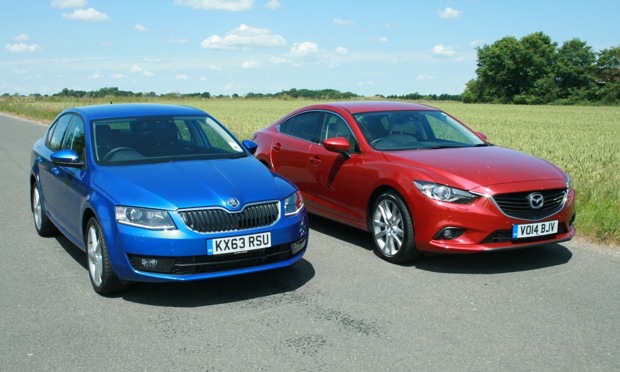
Date: 23 May 2014 | Current mileage: 3009 | Claimed economy: 68.9mpg | Actual economy: 55.3mpg
After three months and 3000 miles the Octavia has reached the halfway point of its long term loan and it continues to impress the Powell household, with a large cabin and excellent all round refinement. In fact, regular readers will know that I’ve become quite a fan of the blue hatchback, but how does it compare to its rivals?
Well, this is an interesting point, because car journalism is all about comparisons. After all, our job is to help you - the reader - make the most informed decision when it comes to buying a new car. So, being keen to compare my Skoda with a rival car, of equal value, I raised a straw poll in the office, and the Mazda6 came out tops as a worthy competitor. We're big fans of the big '6' and some quarters of HJ Towers claim it to be better than the Octavia, but keen to find this out for myself, I got hold of one.
To perform a fair comparison, I chose a Mazda6 in the range topping Sport Nav trim, which matches my Octavia’s Elegance trim. When it came down to engines, I opted for the 2.2 Skyactiv diesel and 175PS. Admittedly, this engine is a little more powerful than the Octavia’s 150PS 2.0-litre TDI, but the performance figures are relatively similar with both cars covering 0-62mph in around eight seconds and capable of 130+mph.
When it comes to exterior shapes, the Mazda 6 is the winner, with a sleeker, sportier appearance. The sweptback headlights give the Mazda a much more prominent front, while the Octavia looks almost square in comparison. The ‘6’ also benefits from an aggressive, sharper grille, along with sloping lines that carry all the way to the boot. The Octavia is not an unattractive car by any means, but the Mazda design is clearly a league above Skoda’s styling.
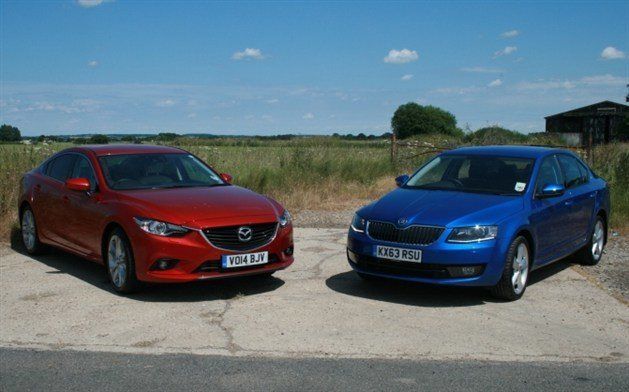
The Mazda takes the lead when it comes to exterior styling, with a sleeker, sportier appearance
However, when you compare the interiors, the Skoda claws back a lot of ground, with the Octavia’s cabin beating the ‘6’ on almost every level. For us, the Skoda feels a lot more user friendly, with a modern design and easy to read dials. In comparison, the Mazda feels dated, with small LED displays and an abundance of cheap plastics.
The Mazda's driving position also lacks the fluency of the Skoda, with a button clad steering wheel and a difficult to read and use infotainment system. In comparison, the Skoda feels a lot more upmarket, with a minimalist approach and intelligent layout. However, things improve in the Mazda’s favour in the back, with plenty of head and leg room for rear occupants. The Skoda is large too, but we think the ‘6’ has a little more leg room.
Being a saloon, the Mazda6 has 489 litres of boot space, which can be difficult to access due to its small opening. In comparison, the Octavia hatchback is much better, with a whopping 590 litres of storage. Not only is the Skoda bigger, but the boot is a lot more practical, with a wide opening that makes it easy to fit large items.
For us, practicality is a chief point for a large saloon/hatch and the Octavia is clearly designed with families in mind. Skoda also offers some useful storage options, with a set of nets (£50) and the Simply Clever pack, which includes a double sided boot floor.

The Skoda Octavia outstrips the Mazda 6 on practicality with a bigger boot that's easier to access
Fortunately, on the road, the Mazda 6 redeems itself. Not only is it a great car to drive, but we also like its diesel engine, which is powerful, refined and quiet. The 175PS version is the best of the bunch when it comes to the 2.2 diesel in the Mazda, with plenty of torque and just 119g/km of CO2. There is a 150PS option, which is more economical, but you have to work it harder to get meaningful performance.
The 2.0 TDI in the Skoda is a fine engine, but lacks the cutting edge and refinement of the Mazda. When it comes to performance, the Skoda almost matches the Mazda stride for stride, with both cars capable of 130mph. You can get the 2.0 TDI with 184PS, but this is only available as a vRS and comes with sports suspension and a firm ride.
However, both cars drive well and are well suited to motorways, with little road noise. There's also fun to be had on B-roads, with both cars handling well. When it comes to economy, however, the Skoda is much more pocket friendly, with cheaper road tax and a claimed 78.5mpg. The Mazda returns 62.8mpg in comparison.
So, which car would I buy? Well, there’s no denying the pedigree of the Mazda 6 – it looks great, has a good range of engines and is fun to drive. But for me, it doesn’t come close enough to topple the Skoda Octavia, which is the better package, with a good engine, practical cabin and modern design. The Skoda is also cheaper, with the 2.0 TDI Elegance starting at £22,310. To get the 175PS Mazda 6 you will have to fork out £26,295.
The petrol or diesel dilemma
It’s an age old question, but does diesel really out shine petrol? Dan uses the new HonestJohn.co.uk Fuel Cost Calculator to find out.
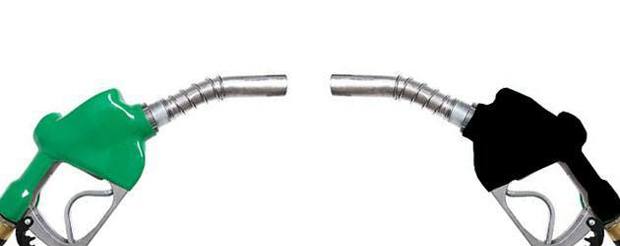
Date: 6 June 2014 | Current mileage: 3480 | Claimed economy: 68.9mpg | Actual economy: 51.3mpg
So, there you are, sitting in a nice car showroom, sipping a free cup of coffee and listening to a car salesman waffle on about the latest and greatest new cars. You've found the make and model you want to buy and you're almost ready to commit, but there’s one last decision to make: do you buy a petrol or a diesel?
To be fair, we’ve all been there, just a few months back I was having the same quandary when I was ordering my Skoda Octavia. Selecting the colour, trim and options took just a few minutes, but it took me an absolute age to make the call between the petrol and diesel engine.
Each month Ask HJ receives hundreds of questions asking the very same thing. As a result we’ve launched the Fuel Cost Calculator. It is simple to use and compares two cars to find the lowest fuel cost. Unfortunately, the calculator wasn’t online when I ordered the Skoda and I was forced to use my gut instinct. However, with the feature now running, I decided to use it to see how the diesel compares to the petrol Octavia. Would it be cheaper? Or have I made a huge gaff?
Well, when I was in the process of ordering the Octavia, I was torn between the 1.4 TSI petrol and the 2.0 TDI diesel; both units are similar in output and have plenty of poke. However, on paper, the diesel was the cheapest to run, with annual VED of £20 and a claimed 68.9mpg. In comparison, the petrol was £110 to tax and returned 53.3mpg. The only catch was the price, with the diesel costing an initial £1750 extra. At the time I questioned the money saving of the diesel, but my gut instinct was the diesel would work out cheapest overall.
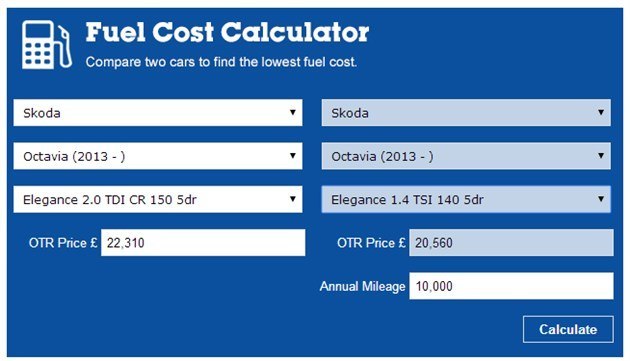
Dan awaited with baited breath as the Fuel Cost Calculator compared the petrol and diesel Octavia
Filling in the details to the Fuel Cost Calculator took just a few seconds, thanks to some useful drop down boxes, which allowed me to compares a petrol and diesel Octavia with a few mouse clicks. However, the results were rather surprising, to say the least.
For a start, the diesel Octavia would only provide an annual saving of £310, which surprised me because it means the initial extra cost of £1750 for the 2.0 TDI would take 56,412 miles or 2059 days to break even with the 1.4 TSI petrol. That’s a long time to wait.
However, after a bit more digging, I found that my call for the diesel was still the correct one. You see, hypothetically speaking, I would keep the Octavia for eight or nine years, which means I would cover 90,000+ miles. As a result, the diesel engine would save me £1040. Admittedly, it could be argued that the higher maintenance costs of a diesel might wipe out this surplus, but I’m confident that I’d still be quids in with a diesel Octavia. But, not everyone keeps cars for 90,000 miles and if you fall into this bracket then the diesel will not be for you.
But don't take my word for it, try the Fuel Cost Calculator for yourself to see how your car weighs up against its petrol, diesel or hybrid alternative. The results might surprise you...
Marking D-Day's 70th anniversary
Dan heads to Normandy in France to mark the 70th anniversary of D-Day.

Date: 20 June 2014 | Current mileage: 4232 | Claimed economy: 68.9mpg | Actual economy: 57.9mpg
A couple of weeks ago the world marked the 70th anniversary of D-Day in Normandy, France. As a result, hundreds of veterans and thousands of tourists flocked to the north coast of France to mark the historical moment. Being a fan of all things historic, I went along with my family (and the Octavia) to take in the huge spectacle.
I’ve always wanted to visit Normandy and the 70th anniversary gave me the perfect excuse to take the family away. The trip started with the usual jaunt to Dover, with a packed ferry crossing to Calais. From there, we embarked on a 185-mile trip to Normandy. Being a keen summer holiday type of guy, I choose a nice beach front hotel in Deauville, which took three hours to reach from the ferry port, via the French autoroute.
As mentioned in previous updates, the Octavia is built to munch the motorway miles and it was the perfect companion for the long morning run to Normandy. To save fuel, I used the ‘Eco’ driving program, which optimises the engine and gearbox to improve economy. I also employed the car’s cruise control too, which saw economy reach 57mpg.
Once in Normandy, I drew up a plan of places to visit, which included a number of D-Day landing sites and museums. The roads of northern France are pretty similar to England, with an abundance of narrow country lanes and wide dual carriageways. However, the Skoda took everything in its stride and ensured that my passengers were transported in quiet comfort.
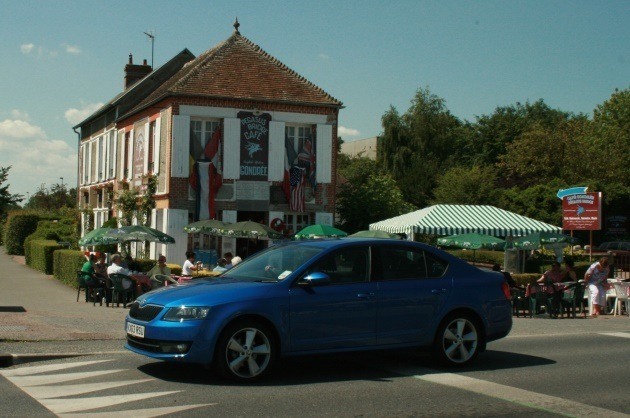
Situated next to Pegasus Bridge, Cafe Gondree was the first building to be liberated on D-Day. The build has hardly changed over the past the 70 years
Our first stop was Pegasus Bridge – a key landing site for the British airborne. The bridge itself crosses the River Orne and Caen Canall and in 1944 provided the only exit eastwards from coastal town of Saint-Aubin-sur-Mer. The small French resort was one of the five main landing sights (Sword Beach) and it was down to the 6thAirborne Division to land a few miles inland and capture the bridge before the occupying forces had chance to blow it up and halt the British offensive.
Today the bridge is home to a museum, which provides a superb timeline to the D-Day landings. It also houses a replica of the Horsa glider that was used to great effect by the British airborne to land undetected in France in the hours leading to the beach offensive. Visitors can also grab a coffee at Cafe Gondree, which was the first building to be liberated in France.
From Pegasus, we moved north to the coast and visited a number of the beach landing sites, which included Sword, Utah, Omaha and Gold. Each site houses a dedicated museum, but a special mention must go to the the Overlord Museum at Omaha.
Founded by Michel Leloup – who was 15 when he observed the landings – the museum houses a huge collection of D-Day artefacts, including tanks, jeeps and weapons. I managed to get a snap of the Octavia parked next to a freshly restored M4 Sherman tank (pictured above). The M4 was used by both the Americans and British in WW2 and packs a punch, with a 75mm turret gun and a .50 cal Browning M2HB machine gun. Weighing 30 tonnes, the M4 could cover 120 miles with a 400PS Continental-built air-cooled engine.
Obviously, the Octavia cannot match the M4 for pure awesomeness, but it fulfilled its mundane family transport duties nonetheless. The four days in France were some of the hottest of the summer to date, but the Octavia’s air con coped with the elements, even when Eco mode was employed. It also completed the trip on three tanks of fuel, averaging 57.9mpg, which saved me a few quid on the holiday too. Next week, I'll be heading to Cornwall, but you'll have to wait two weeks to see how the Octavia copes with that leg of my holiday.
Go west, where the skies are blue
Dan and his Skoda head to the west country to enjoy the sun, sea and Lands End.
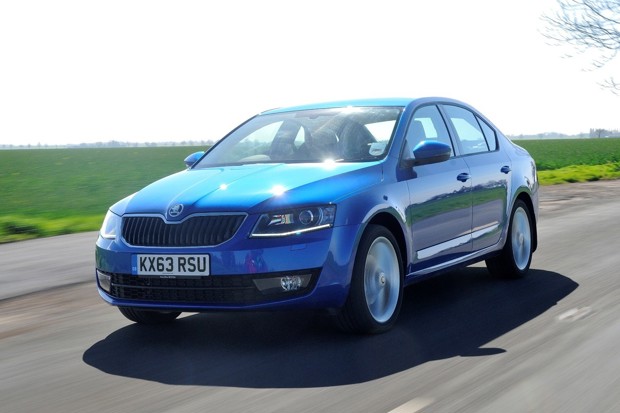
Date: 4 July 2014 | Current mileage: 4972 | Claimed economy: 68.9mpg | Actual economy: 60.1mpg
It has been a busy time for the Skoda Octavia and over the past month I’ve clocked up almost 1500 miles, with trips to Normandy and Cornwall. Clearly, it is holiday season in the Powell household, but the Skoda has not had a moments rest.
Buzzing along the M4, the Skoda excels as a classy and refined motorway cruiser, with minimal road noise and a calm ride. Even with a full boot, the Octavia remains responsive and agile, which makes it a real pleasure to drive.
My week long holiday in Cornwall involved the usual mix of driving and sightseeing, with visits to the Eden Project, St Michael's Mount and Land’s End. As you can imagine, with so much driving, I was able to explore all aspects of the Octavia and I found myself asking: is this the best family car money can buy?
Well, in short, I think the answer is yes. During my career I’ve experienced all manner of large saloons and hatches, yet few affordable cars can match the Octavia for its usability and rewarding drive. It would appear that the Honest John users agree with me, with the Skoda being voted Best Large Family Car of the Year in our awards.

It was the end of the road for the Octavia at Land’s End...quite literally
However, as I neared the end of my holiday, there was one aspect of the Octavia that bugged me: the sat nav. Like Normandy, the roads of Cornwall are narrow and bumpy, but for the most part the Skoda coped rather well. Unfortunately, the same cannot be said for the navigation, which insisted on sending me down every godforsaken farm track, B road and path it could find.
It didn’t matter how remote or obscure the route or how narrow the road, the sat nav insisted on using them. At first it was entertaining to head down a narrow country lane and see the countryside; however, after a while, it became rather tedious, as I started to meet tractors and all manner of farm vehicles coming the other way. Had I inadvertently asked the sat nav to take me on these routes or was it just confused?
After reading the manual and playing with the in car settings I came to the conclusion that the lack of GPS signal and reduction in main roads had resulted in a confused sat nav. Instead of using regular roads, it has simply chosen the shortest route it could find, which is a bad idea in a place like Cornwall.
The sat nav also proved to be rather cumbersome in town, with delayed directions and unhelpful directions. I have to admit, that for the past few months, the directions have been okay from my computerised friend, but in Cornwall it lost the plot.
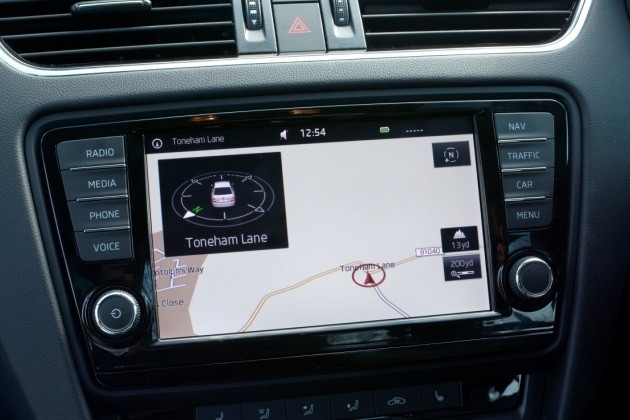
Like a plot from a bad horror film, the sat nav insists on using isolated B roads
Yet, sat nav grumbles aside, I am still very happy with my Skoda. It’s big, comfortable and hugely efficient. In fact, I completed a week long holiday with just two tanks of fuel.
Sadly, my time with it is nearing an end – I return it next month – but I will embark on a few more trips before then. However, next time I visit the countryside, I think I will pack an old fashioned map and give the cross country excursions a miss...
Are car extras a waste of money?
Are optional extra really useful or are they complete waste of money?

Date: 18 July 2014 | Current mileage: 5036 | Claimed economy: 68.9mpg | Actual economy: 59.8mpg
When it comes to car options, the choices are seemingly endless. In fact, during my years as a motoring journalist, I’ve seen all manner of stuff, from mini beer fridges to 31-piece gun cabinets, complete with high velocity ammunition. You name it, someone has added it to a car for a hefty mark-up, which raises an important question: are car options just a waste of money?
Well, if we use the Octavia as a case in point, the answer is yes and no. When it came to ordering my Skoda, I was quite impressed with the options list, spending £5500 more on extra bits and bobs. Over the past five months, some of it has been really useful, while other things have been a complete waste of time and money.
At the top of the chart are the boot nets. Priced at £50, these little nets have without a doubt been invaluable, allowing me to carry everything. The rear of the Octavia is huge and this means things like shopping, luggage and even a bike will shift along in the back and bump into the sides. But, with the optional nets fitted, I've been able to store, tie down and hold everything in place. For the sake of £50, the nets have been brilliant.
Another option which has been a no brainer is the Bluetooth, which is easy to use and set up. Simply pair up the phone with a few button clicks and that's it. Each time you climb into the car the phone will pick up the car's signal and automatically connect itself. Likewise, the Canton sound system (£400) has also been easy to use and enjoy, with enhanced sound quality and a great base. But I'd only recommend this for true music fans.
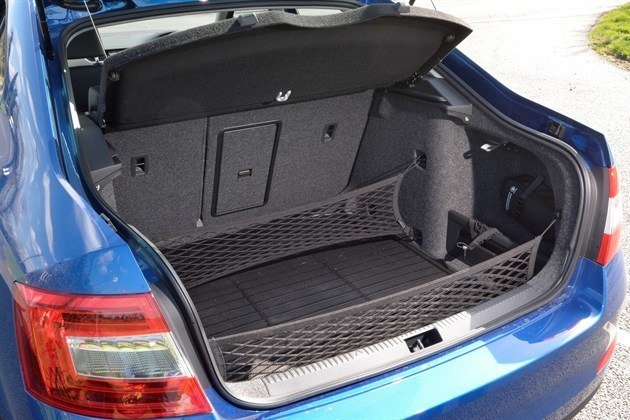
The Octavia's boot nets are brilliant and only cost £50 extra.
The Octavia’s seats are also worth another mention, with the leather upholstery and heated front seats (£600) being ideal for long trips. Not only are they supportive and luxurious in the front, but the Octavia will also carry three across the back in comfort. However, the electrically adjustable front seats (£700) have been largely a waste of money; they are no substitute for a manual lever and do little to improve in-car comfort.
I’d also skip the sat nav (£800) which has been hesitant and difficult to use. Not only does the system miss turnings and struggle with multiple roads, but it also goes AWOL when you reach the open country and will do its best to use every B road or single track lane it can find. For £800, you’d be better off spending a fraction of the cash on a TomTom and a paper map.
The jury is also out on the Bi-Xenon and LED daytime running lights (£1050) which are great, but difficult to justify for the outlay. Personally, I'm big fan of Bi-Xenon as I think they're far superior compared to halogens. I also think they're very stylish - I also added the LED rear lights at £300 - but this will all be down to taste. If you're not fussed about LEDs or ultra-bright headlights, then you probably won't want to spend £1350 on these extra toys.
However, I would recommend the 18-inch 'Golus' alloy wheels (pictured at the top), which look great. The metallic is also worth the extra spend, with the Race Blue paint working really well on the Octavia. Not only is it eye catching, but it also gives the car a sporty edge. Equally, the Simply Clever pack (£80) has been useful, with a phone holder and double sided floor boot floor covering. Perfect for use with those brilliant boot nets, which are close to being the best invention since silenced bread.
Final thoughts on the Skoda Octavia
After an enjoyable six months, Dan gives his final thoughts on the Skoda Octavia.
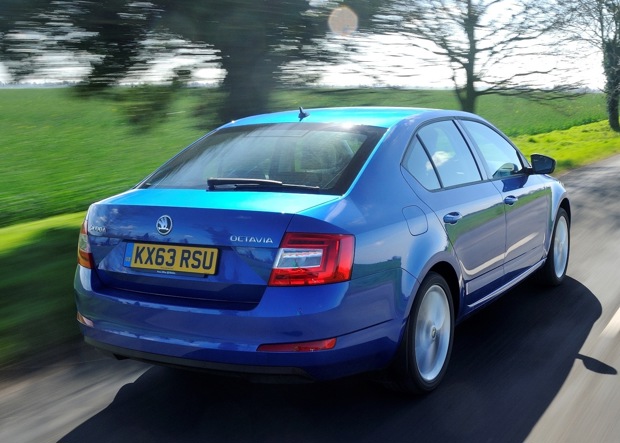
Date: 1 August 2014 | Current mileage: 5591 | Claimed economy: 68.9mpg | Actual economy: 58.4mpg
The time has come for me to go through the dreaded “it’s not you, it’s me” routine with the Skoda Octavia. You see, my six month loan has come to an end and I have (quite literally) been forced to return the keys and bid a teary farewell to the Octavia. But, as the music industry said to Jedward: don't be said that it's over, be glad that it happened.
As you've probably gathered, I grew increasingly attached to the Octavia - not only is it a brilliant and practical hatchaback, but was also great fun to drive, with an attractive design and stylish interior. Indeed, over the past six months, I covered 5500 miles and travelled all over the UK and northern Europe. Yet, on each occasion, the Octavia fulfilled its duties with economical ease.
Over the six month loan the Skoda averaged between 55-61mpg, which made it a relatively cheap to run, given its gargantuan size and pokey 2.0-litre diesel engine. This meant I was able to fill it up and run it for long durations, without having to worry about finding fuel stations.
However, the long term loan wasn't without its problems. In fact, things started off rather badly when some git reversed into the Octavia and drove off without so much as a note to say sorry. Thankfully my local Skoda dealer fixed my car and it was trouble free from there on. The Octavia really is an outstanding car, which probably explains why it was voted by HonestJohn.co.uk users as large family car of the year 2014.

The Octavia has impressed Dan with its excellent economy and punchy 2.0-litre turbodiesel engine
The two big plus points for the Octavia lie in its refinement and 2.0-litre engine. Both are very impressive, with quiet running and superb performance. When I specified the Octavia I chose the 150PS turbodiesel and it really is excellent, with plenty of torque and a 0-62mph time of 8.5 seconds. However, the Volkswagen-sourced engine is also extremely economical with just 106g/km of CO2, which means it qualifies for Band B car tax.
Admittedly, the Skoda fell short of its claimed fuel economy of 68.9mpg, but its rewarding drive and refined interior more than made up for this. The interior of the Octavia is huge and I didn't get a single complaint about head or leg room from any of my passengers. Equally, the 590-litre boot proved to be extremely useful, taking everything from the weekly shop to a couple of mountain bikes, with the rear seats down.
So, what about the negatives? Well, there are not many, but I would say that the navigation is disappointing and the rear doors can clip a small child, due to their pointy nature. Actually, if you own kids, you will want to help them in and out of the back as the sculpted door can hit them in the face if not opened carefully. We’ve noticed the same problem with the doors on the Volkswagen Passat estate, which are really similar, although the curves are not as pronounced. But, with a bit of parental guidance, most kids will get in and out without problem.
However, small niggles aside, there is very little else to complain about. The Skoda Octavia is big, fun to drive, attractive and extremely economical. In fact, I’d go on record to say it is quite simply one of the best large hatches money can buy. It really is that good.

